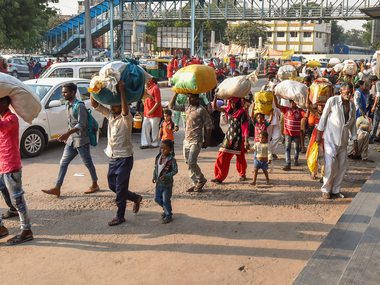Over the course of its development, every country experiences a drop in its birth and death rates; the former due to better education among other factors and the latter due to better healthcare. The fall in fertility and death rates drives the demographic change where the population in working age rises faster than those outside it, who are usually dependent on the former for survival. The resulting accelerated economic growth due to higher levels of income, savings and productivity is known as the demographic dividend. Following the usual trajectory of development, India has also experienced a marked deceleration in its population growth, from 2.5 percent during 1977-81 to 1.3 percent as of 2011-16. And the slowdown is expected to continue in the coming decades. [caption id=“attachment_5347031” align=“alignleft” width=“380”] Representational image. PTI[/caption] India’s fertility rate, or the number of children born to each woman, has halved since 1980. The average fertility of the country between 2015 and 2020 stands at 2.2 per woman against an average of 4.97 recorded between 1975 and 1980. The current fertility rate is very close to the replacement level of 2.1 percent, which is the number of children needed to replace their parents. A fertility rate below the replacement level will imply a fall in the country’s population. These figures indicate that India is entering the transition phase where the years with low population growth can be combined with high economic growth by exploiting the full potential of its human capital. But since India is such a vast country with contrasting trends across the land, different states can be found at different levels of demographic transition. This has been depicted in Figure 1. The graph shows that the share of the working population will be declining for most of the states in the southern region. Kerala’s working-age population will experience a sharp fall from 56.2 percent in 2021 to 52.8 percent in 2041, while Tamil Nadu’s workforce size would shrink by 2.8 percent during the two decades starting from 2021. On the other hand, due to the high fertility rates in the central and the northern region, the growth potential for the country is largely locked in states like Bihar, Uttar Pradesh, and Madhya Pradesh. By 2041, only four states—Bihar, Madhya Pradesh, Maharashtra, and Uttar Pradesh—will contribute to 43 percent of the country’s working-age population.
The difference in the levels of demographic dividend can be explained through the total fertility rate (TFR). Thirteen out of twenty-two major states now record fertility rate below the replacement rate of 2.1 as can be seen in Figure 2. The rest of the states that have a higher TFR than the replacement rate, which implies that their population will keep on rising over the next few decades allowing for a rise in the working population and, thus, the demographic dividend.
These regional differences in the age structure have significant policy implications for the states. A mere presence of the labour cannot assure high levels of growth and development. To exploit the time-specific window of opportunity, northern states, which will have a higher share of the working-age population, should focus on policies that will enhance the productivity of their workforce and will bring more job opportunities. This implies a larger focus on the provision of health infrastructure with a greater emphasis on child health, programmes to address issues such as child marriages, and policies to improve the quality of education system and ensure gender parity in education. On the other hand, the states where the demographic window is closing soon can explore further opportunities for economic development by encouraging woman to join the workforce. Moreover, to support the elderly, policymakers in these states should also focus on improving their social security and pension systems as dependency rates will increase. In a nutshell, the regional diversity in the age structure requires Indian states to work on different policy lines by factoring in population dynamics to reap the socio-economic benefits. (This analysis is presented in association with Institute for Competitiveness.)


)

)
)
)
)
)
)
)
)



